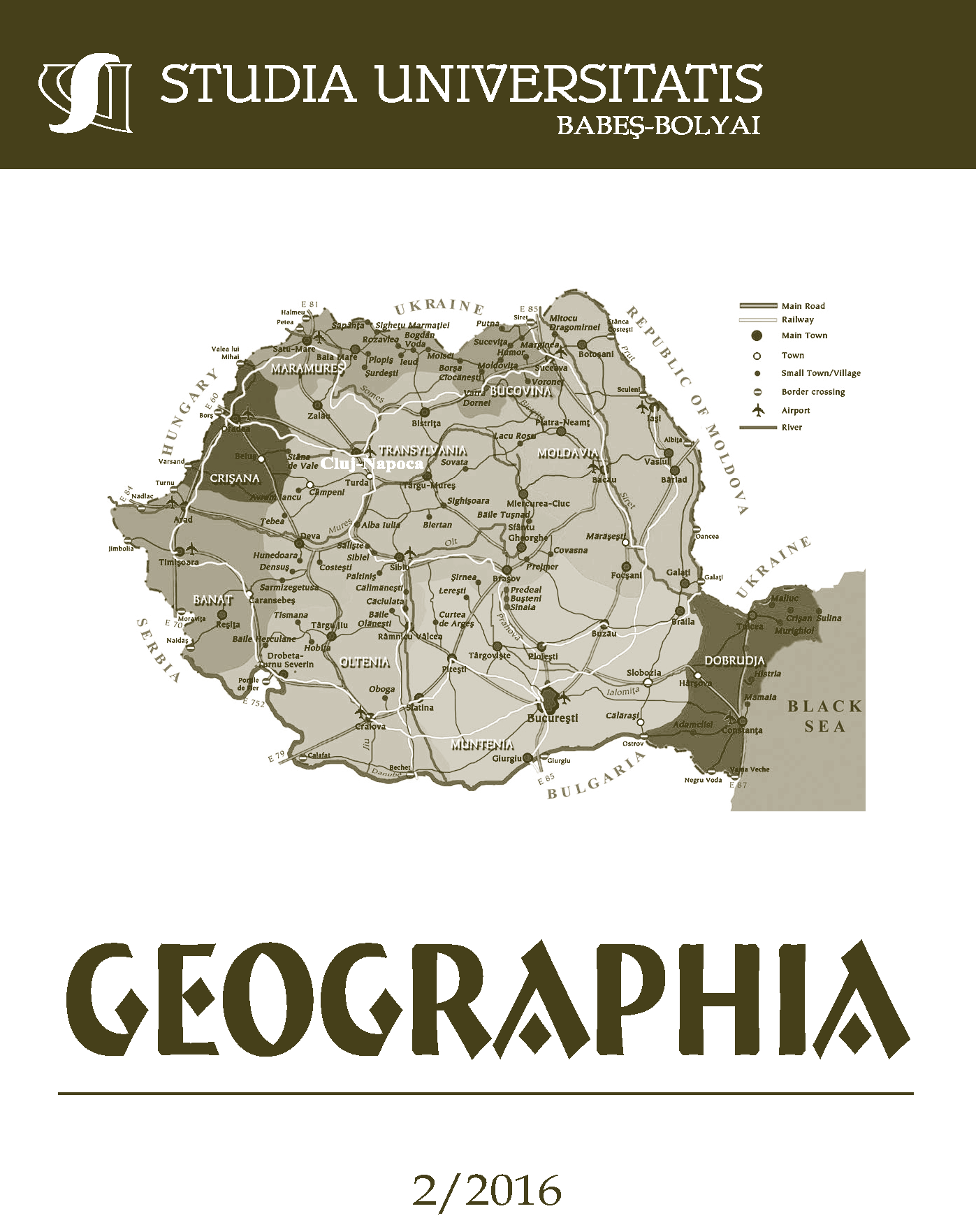THE LOSS OF VILLAGES IN ROMANIA AFTER 1990
Keywords:
settlement dissapearance, depopulation, evolution stages, typology of dissapeared villages, built-up area, functional transformation, functionality and decline of human settlement.Abstract
The Loss of Villages in Romania after 1990. Settlement development is a continuous process significantly influenced by population dynamics. Population decrease through migration and low birth rate has become an issue at European level, and in the case of Romanian rural areas the situation proves even more severe. The aim of our study is to analyse the evolution of rural settlements from emergence to decline based on a seven-stage development cycle and emphasize on the phenomenon of rural settlement disappearance in Romania after 1990. Results show that even without first-sight visible or significant effects at national level, the number of rural settlements that have disappeared is continuously increasing, therefore becoming an issue for the development of rural areas. Particularities of the current condition of the built-up area of each of the analysed villages revealed various levels of destruction from incipient decline (whole built-up area) to total collapse (very few remains of the built-up area, and even incorporated in the natural environment). We thus create a typology of disintegrated villages, which are currently found at national level and we reveal their administrative and geographical distribution. We conclude that settlement evolution and the risk of their disappearance should be on the shortlist of priorities of the national policies, strategies and projects designed for the development and planning of rural areas.
References
Ghinea Eliza, Ghinea D. (2000). Localitățile din România. Dicționar, Edit. Enciclopedică, Bucharest.
Heijman, W., Hagelaar, G., van der Heide M. (2007). Rural resilience as a new development concept, in D. Tomić and M.M. Ševarlić (eds), Development of Agriculture and Rural Areas in Central and Eastern Europe. Thematic Proceedings of the 100th Seminar of the European Association of Agricultural Economists. 21-23 June 2007, Novi Sad, Serbia, 383-396.
Karcagi Kováts, Andrea, Katona Kovács, Judit (2012). Factors of population decline in rural areas and answers given in EU member states’ strategies, Studies in Agricultural Economics 114 (2012) 49-56. Retrieved from: http://ageconsearch.umn.edu/bitstream/122451/2/Factors%2bof%2bpopulation%2bdecline%2bin%2brural%2bareas%2band%2banswers%2bgiven%2bin%2bEU%2bmember%2bstates%2527%2bstrategies.pdf
Mandal, R. B. (2001). Introduction to Rural Settlements, Concept Publishing Company, New Delhi, India.
Mella P. (2012). Systems Thinking. Intelligence in Action, Springer, Italy.
Noga Collins-Kreiner (2013). The Life Cycle Concept & the Evolution of Villages, Journal of Applied Economics and Business, Vol.1, Issue 1 – May, 2013, pp. 5-14. Retrieved from: http://www.aebjournal.org/articles/0101/2_Noga%20ColinsKreiner.pdf
Suciu C. (1966). Dicționar istoric al localităților din Transilvania. Vol. 1, Edit. Academiei Republicii Socialiste România, Bucharest.
Suciu C. (1968). Dicționar istoric al localităților din Transilvania. Vol. 2, Edit. Academiei Republicii Socialiste România, Bucharest.
van der Schoot, F. (ed.) (2014). Attract and Connect. Population Decline and the Heritage in Europe. With practical examples from Germany, the UK, France and the Netherlands, Cultural Heritage Agency, Amersfoort, The Netherlands. Retrieved from: https://cultureelerfgoed.nl/sites/default/files/publications/attract-and-connect-population-decline-and-the-heritage-in-europe.pdf
Westhoek, H.J., van den Berg M., Bakkes, J.A. (2006). Scenario development to explore the future of Europe's rural areas, Agriculture, Ecosystems and Environment 114 (2006) 7–20. DOI: http://dx.doi.org/10.1016/j.agee.2005.11.005
*** European Commission (2014), The 2015 Ageing Report: Underlying Assumptions and Projection Methodologies. EUROPEAN ECONOMY 8|2014. Retrieved from: http://ec.europa.eu/economy_finance/publications/european_economy/2014/pdf/ee8_en.pdf
*** (1968). LEGE nr. 2 din 16 februarie 1968 privind organizarea administrativă a teritoriului Republicii Socialiste România, cu modificările și completările ulterioare. Retrieved from: http://www.cdep.ro/pls/legis/legis_pck.htp_act?ida=15549
*** (2001). Legea nr. 351/2001, privind aprobarea PATN – Secţiunea a IV-a – Reţeaua de localităţi, cu modificările şi completările ulterioare. Retrieved from: http://www.cdep.ro/pls/legis/legis_pck.htp_act_text?idt=28862
*** (2015). Lista localităților fictive din România (dispărute sau depopulate). Retrieved from: https://docs.google.com/spreadsheets/d/1cJkGQ5Uh97zy2Qomu5ZWh4YeC0hYILGImh-eAiFEUUk/edit#gid=0
*** Ministry of Agriculture and Rural Development (2014). National Rural Development Programme for the 2014 – 2020 period. Retrieved from: http://www.madr.ro/docs/dezvoltare-rurala/programare-2014-2020/PNDR_2014_EN_-_2020_01.07.2014.pdf
*** Ministry of Regional Development and Public Administration (2014). Studiu de fundamentare în vederea actualizării P.A.T.N. – Etapa I; vol. 2. Retrieved from: http://www.mdrap.ro/userfiles/PATN_etapaII_vol_1_2.pdf
*** National Institute of Statistics (1992). National Census of Population and Households, Bucharest.
*** National Institute of Statistics (2002). National Census of Population and Households, Bucharest.
*** National Institute of Statistics (2011). National Census of Population and Households, Bucharest.
*** National Institute of Statistics (2015). Romanian Statistical Yearbook. Retrieved from: www.insse.ro/cms/sites/default/files/field/publicatii/anuarul_statistic_al_romaniei_1.pdf
*** National Institute of Statistics (2016). Romanian population statistics at January 1st, 2016, Bucharest. Retrieved from:
*** United Nations, Department of Economic and Social Affairs, Population Division (2015). World Population Prospects: The 2015 Revision, Key Findings and Advance Tables. Working Paper No. ESA/P/WP.241. Retrieved from: https://esa.un.org/unpd/wpp/publications/files/key_findings_wpp_2015.pdf
*** United Nations, Department of Economic and Social Affairs, Population Division (2015). The World Population Situation in 2014. A Concise Report. Working Paper No. ST/ESA/SER.A/354. Retrieved from: http://www.un.org/en/development/desa/population/publications/pdf/trends/Concise%20Report%20on%20the%20World%20Population%20Situation%202014/en.pdf
*** Open Data Hackathon (2015). Retrieved from: https://localitatifantoma.wordpress.com/hackathon-2015/
*** Open Access Statistical Data, Romanian Government. URL: http://data.gov.ro/
*** Open Access Map Resources – INIS Viewer Inspire Geoportal – http://geoportal.ancpi.ro/geoportal/viewer/index.html
*** Recent Satellite images – Google Maps. Retrieved from: https://www.google.ro/maps/
Downloads
Published
How to Cite
Issue
Section
License
Copyright (c) 2016 Studia Universitatis Babeș-Bolyai Geographia

This work is licensed under a Creative Commons Attribution-NonCommercial-NoDerivatives 4.0 International License.





 ©Studia Universitatis Babeş-Bolyai Geographia. Published by Babeș-Bolyai University.
©Studia Universitatis Babeş-Bolyai Geographia. Published by Babeș-Bolyai University.